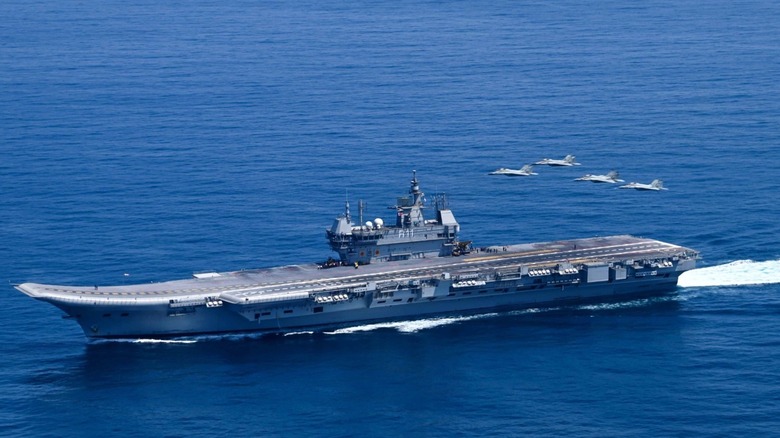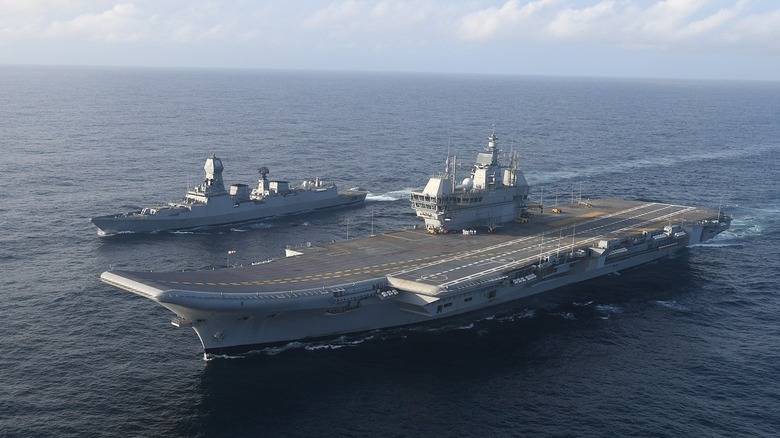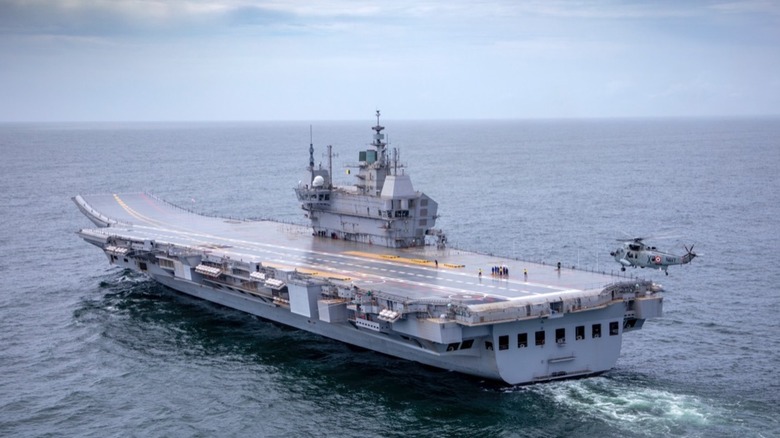INS Vikrant: A Look At India's Destructive (And Massive) Aircraft Carrier
India and Pakistan have recently made headlines as brewing tensions between the two nations have boiled over into open conflict, with dozens killed in missile and drone strikes before a temporary ceasefire was negotiated. This has brought wider attention to the military capabilities of both countries, including the destructive Indian aircraft carrier INS Vikrant. Because it was recently commissioned into service in 2022, the INS Vikrant is one of the most advanced vessels on the seas, building on designs and technology utilized in the nation's previous Kiev-class INS Vikramaditya, which is a modified Soviet carrier built in the 1980s.
Unlike its predecessor, the INS Vikrant was built entirely in India and is the fourth aircraft carrier India has included in its armed forces. Today, it's one of two active carriers in the Indian Navy, with plans to build another Vikrant-class carrier modified for enhanced drone capabilities. There are different types of aircraft carriers used by navies — the INS Vikrant is a STOBAR craft. This stands for "short take-off but arrested recovery," which means that the ship has a ski-jump ramp on one end that helps aircraft launch into the air with less runway, as well as arrestor wires that aircraft can catch with tailhooks to allow quick stops during landing.
While this system is cheaper and easier to maintain than the powered catapults used to assist take-offs on CATOBAR aircraft carriers, it's only suitable for lighter aircraft. This means the Vikrant can't launch heavy strike or larger surveillance planes, but is perfect for India's Mikoyan MiG-29Ks, Soviet-designed short-range fighter jets that can go head-to-head with F-16s. The STOBAR carrier can also easily launch helicopters and despite the fact that larger planes can't take off from it, the INS Vikrant is one of the largest aircraft carriers in the world.
Just how big is the INS Vikrant?
The INS Vikrant is 852 feet long, which is about two-and-a-half football fields in length. With 14 decks, the ship is nearly 194 feet tall at its highest point, taller than many residential buildings, and is about 203 feet across at its widest point. It sits about 27 feet in the water and displaces a whopping 40,000 to 45,000 tons when fully loaded. Like other carriers of its size, the Vikrant is nothing short of a floating city and can house a crew of 1,700, including 160 officers and 1,400 sailors. It can operate up to 40 aircraft at once, making it a formidable force in India's navy.
The INS Vikrant can travel 8,000 nautical miles (or around 45 days) before needing to be resupplied. One of the interesting facts about aircraft carriers that you may not have known is that — despite their size — they can move across the water pretty quickly. The INS Vikrant is no exception and has a maximum speed of 28 knots, which is roughly equivalent to 32 mph. The massive vessel is able to go this fast thanks in part to its four LM2500 gas turbines, which can generate up to 80 megawatts of power. The LM2500s were built by General Electric in Evendale, Ohio and tested by aerospace company HAL in Bangalore, India. The ship's modern power system is designed to be heavily automated.
The 'courageous' INS Vikrant is armed to the teeth
Though its design was approved way back in 2003 and construction began in 2007, with the keel being laid in 2009, the INS Vikrant wasn't commissioned until 2022. Since it's relatively new, the ship has mostly been used in military exercises and has avoided any actual conflict during its first few years of its existence. That changed in May 2025, when India and Pakistan attacked each other's territory before agreeing to a temporary ceasefire.
Tensions have existed between the two South Asian nations since they were originally partitioned and freed from British colonial rule in 1947, with the territory of Kashmir claimed by both. India and Pakistan have gone to war multiple times since — the INS Vikrant is actually named after a previous vessel that fought in the 1971 India-Pakistan War and was an important symbol of national pride for India. ("Vikrant" means courageous in Sanskrit.) With another war between India and Pakistan threatening to break out, the INS Vikrant has been deployed to the Arabian Sea west of both nations and would undoubtedly play a major role in the conflict.
In addition to carrying up to 40 fighter jets and helicopters, the INS Vikrant is equipped with 32 surface-to-air missiles, 16 cruise missiles, four torpedo launchers, an Oto Melara 76-millimeter gun, and four AK-640 CIWS cannons. The ship can also serve as an operations center for real-time intelligence and surveillance, as well as electronic and cyber warfare. Plus, it's not alone — the Vikrant leads a carrier strike group of several other seacrafts that are fully armed to the teeth. This includes warships, destroyers, anti-submarine vessels, frigates, and support ships — some of which have stealth missile capabilities — adding to the INS Vikrant's formidable presence in the Arabian Sea.


